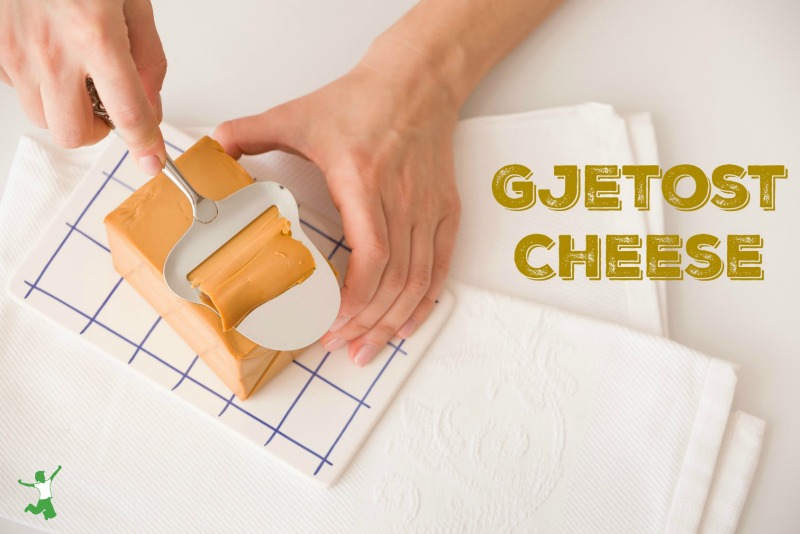Easy recipe for homemade gjetost cheese traditional to Norway that can be made with leftover liquid whey from other culinary activities.
My friend Mary recently mentioned to me that she was drowning in whey.
She had a gallon or two of raw milk that had soured and she wisely decided to allow it to naturally separate on the kitchen counter. She then strained the clabbered milk into cream cheese and whey.
The raw cream cheese could be blended with a bit of maple syrup and strawberries to make a lovely raw spread for a morning bagel, but what about all that whey?
I suggested that some of the whey could be used for fermenting probiotic loaded vegetables and fruits such as beet kvass or sauerkraut. But, Mary said she had so much, there was no chance she would use all of it for that purpose.
Help!
Homemade Gjetost Cheese
In situations like this, use the extra whey to make traditional Norwegian gjetost cheese (pronounced “yay-toast”).
This simple, healthy cheese is made by boiling down whey for a number of hours until it is reduced to a quarter or less of its original volume. When the gjetost cheese is almost ready with the whey almost boiled down, you add some cream to enhance the smoothness and flavor. The color as it boils down gets darker and darker.
Believe it or not, that is all there is to it!
Gjetost cheese tastes somewhat like cultured butter with some cheddar overtones and can be served as a sauce for pasta similar to a creamy alfredo sauce.
You can also use gjetost cheese to flavor vegetables or enhance the flavor of soups.
The idea is to boil it down to the desired consistency for the appropriate culinary use.
You may use the whey from either cow or goat milk to make your gjetost cheese. Know that if you make it from goat whey which is the traditional way to do it, it will definitely taste a bit goaty.

Homemade Gjetost Cheese Recipe
Easy recipe for homemade gjetost cheese traditional to Norway that can be made with leftover liquid whey from other culinary activities.
Ingredients
- 1/2 gallon liquid whey FRESH, not leftover from cheesemaking
- 1/2 cup cream preferably organic and grassfed
Instructions
-
Pour the whey into a large pan and bring to a low boil. Simmer uncovered for 2-3 hours stirring frequently until the whey has been reduced to the texture of thick gravy and is about 1 pint in volume.
* This is a great task to start right after breakfast and it will be done by lunchtime.
-
Stir in cream and continue to simmer stirring often until desired consistency is reached.
-
Remove from heat and let cool for a few minutes. Blend the gjetost cheese with a stick blender to enhance creaminess and serve warm immediately as a pasta sauce or pour into containers to refrigerate for later use.
-
Gjetost cheese will solidify a bit in the refrigerator and will last for about 1 month. It is delicious cold as a spread on crackers.

More Recipes for Homemade Cheese
How to Make Ricotta Cheese
Homemade Quark recipe
How to Make Whey and Cream Cheese
Cheesemaking: Common Problems and Solutions
How to Make Yogurt Cheese
Perfect Cottage Cheese








Perfect timing on this post! Recently, I’ve started making my own greek yogurt with raw milk which is awesome but I’m accumulating more whey than I know what to do with. I’m beginning to experiment with soaking rice & grains, your Lacto-Fer Lemonade and condiments! Can you provide other uses of whey? Is safe to put in smoothies for added protein? Soups? Broth? I ditto Linda’s comment, YOU HAVE CHANGED MY HEALTH & LIFE!
Where did this come from? Gjetost cheese is a sweet almost caramel tasting brown cheese made of GOAT milk, whey, and cream. It shouldn’t be liquid at all and definitely doesn’t taste like butter. I don’t know what you made because it’s not even prim. Gjetost is very specific. At the very least, you should find out what it is that YOU made so people won’t go running around calling it gjetost . . . which it definitely is not. Just like you call that stuff you make ‘cream cheese’, when it isn’t. Well, part of it may be. Just not all.
There are quite a few variations of this cheese yes as I mentioned in the comment above yours.
The result is not liquid at all if you choose to cook it way down. It is of course, your choice how you want the consistency to be which you control with the cooking time.
I prefer a more sauce-like cheese. I learned this from a cheese class I took years ago. It is also called whey cheese (but that name is really boring wouldn’t you agree :)) and there are a number of other names from other countries.
My past experience with Gjetost cheese was at a cheese tasting class in Home Ec studies. It was a hard slicing cheese and had a sweet cartelized taste. Unusual taste for cheese but I liked it very much. Is this sweet or carmelized in taste?
Make that “caramelized”
Some variation of this cheese use some milk and then the milk solids caramelize while it is cooking down and the result is more sweet than what I do with just whey and cream which results in a more savory cheese.
I like this creative solution … I was wondering what to do with raw milk that had turned!
A spoonful is great in mashed potatoes.
I have a question …. I almost said a ‘stupid’ question but then no question is ever stupid right? How can i get just the cream out of my plastic jugs of raw milk?
Let the cream come to the top and then suck it out with a turkey baster.
Oh my gosh thank you Sarah! That’s almost a ‘duh’ question. I just didn’t think of it myself. Thanks for all the wonderful things you do and how you have literally changed my life! 🙂
No worries 🙂 We are all in the process of relearning this wisdom that our grandparents knew as easily as tying their shoes. We have all gotten very dumbed down when it comes to food in the past 70 years or so.
Turkey baster!? that is a great idea! I was just pouring it off the top but that ain’t workin the greatest!
I prefer a different method. I wait to see the cream and milk separate, then I use a thumbtack and punch 3-4 holes at the bottom, i take off the lid and I put it over a glass jar, and watch the milk stream out. As soon as it starts to drip it is the cream, or you can see the cream line has made it all the way down. Then I take off the lid and pour the cream out.
Neat!
I remember as a child watching my Grandma strain her fresh milk through a cloth (like a tea towel or thin cloth diaper or something of that sort. It was much thicker than cheese cloth with a much tighter weave, but it didn’t have loops and pills like terry cloth. I asked her why she did it, and I distinctly remember her answer as if it was 5 minutes ago. She told me she was separating the cream from the milk. At that time, I had no idea what she was talking about but that stuck with me for some reason.
I’m just commenting on the goaty-tasting goats milk. I raised dairy goats and my milk never had a goaty taste and made the best kefir I ever tasted. So not all goat milk is equal I guess…lol
I have to say that I think some folks are unable to taste the goatiness of goat cheese. I have never tasted a goat cheese that I couldn’t detect the goatiness. I have extremely sensitive taste of smell and taste though. Our goat milk has no goat taste when it is very fresh but making any sort of cheese with it always has a slight goaty flavor which some enjoy. I am not particularly fond of it though.
I get a share from a goat farm. Sometimes it tastes goatie and sometimes not at all. I think it can depend on several things. If the does are running with billies. What they are eating in the field. Both play into the time of year. Spring milk seems better than fall milk to me. I did not like the cheese I made last fall. I plan to try cheese again this week as I’m getting extra milk.
I am with you Cheryl. Mine never tastes goaty. Even after being turned into cheese or allowed to ferment.
Thank you for this. I just had my very first milk sour since I started getting it. Raw milk that is. I will be trying this! 🙂
I’ve used whey on my face and postpartum belly, since it has astringent qualities! It really works. I think it had some type of detoxing effect on me, too. I have also let it sit in my hair for a deep conditioning treament before rinsing out. It has done very well getting rid of any itchiness I have. I will definitely have to try the gjetost, especially since there is a lot of Scandinavian blood in my husband’s side of the family (and, ergo, my kiddos). Thanks for the post!
I like this idea also!
Hi Sarah,
Can whey also be frozen for future use of lacto fermentation, soaking grains, etc.?
Thank you,
Sarah
Yes you can freeze whey.